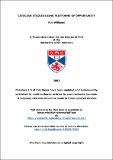Files in this item
Cetacean studies using platforms of opportunity
Item metadata
| dc.contributor.advisor | Hammond, Philip S. | |
| dc.contributor.author | Williams, Rob | |
| dc.coverage.spatial | 237 | en_US |
| dc.date.accessioned | 2012-06-21T15:28:49Z | |
| dc.date.available | 2012-06-21T15:28:49Z | |
| dc.date.issued | 2003 | |
| dc.identifier | uk.bl.ethos.511647 | |
| dc.identifier.uri | https://hdl.handle.net/10023/2836 | |
| dc.description | Chapters 1-5 of this thesis have been updated and subsequently published in multi-authored articles in peer-reviewed journals. If required, citations should be made to these updated articles listed in the full item record below | en_US |
| dc.description.abstract | As human impact on marine ecosystems continues to grow, so too does the need for sound conservation and management strategies that are informed by science. Cetaceans, the whales, dolphins and porpoises, epitomise this challenge, because they are hard to study, they have been heavily exploited in the past, and because some of their habitats, behaviours and life-history strategies make them acutely vulnerable to human activities. Unfortunately, research on free-ranging cetaceans in remote areas is costly, and financial resources are limited. The approach used in this thesis to acquire inexpensive quantitative information on cetacean populations and behaviour was to seek out platforms of opportunity. Tourism and environmental education projects provided access to remote areas of importance to cetaceans. The topic was explored in two main areas. First, studies were conducted to investigate the use of ships of opportunity in estimating distribution and abundance, namely of Antarctic baleen whales. The second area of interest was the effect of boats on killer whales in the northeast Pacific. Platforms of opportunity proved valuable for collecting data to model the role of measurement error on abundance estimation. Measurement error was found to be a potential source of bias in four distance estimation experiments. Platforms of opportunity could be used to train observers on protocols, and to learn to use range- finding photogrammetric equipment well before conducting dedicated surveys, which would eliminate this source of bias, as well as estimating abundance in some cases. Abundance and distribution of three whale species were modelled using data collected aboard Antarctic tourist ships. Spatial modelling techniques were used to model distribution of minke, fin and humpback whales using line-transect data collected from a survey that could not be randomised. Strong gradients in animal density were predicted, which could be used to inform future surveys. In the meantime, rough estimates of abundance were obtained, and this approach shows promise for other areas where lack of resources makes systematic surveys prohibitively expensive. A government-funded environmental education project provided logistical support for two studies that dealt with effects of boats on killer whale behaviour. One quantified the extent to which a particular style of whalewatching was disruptive to whale behaviour, and commercial whalewatchers agreed to halt this activity. The other found that a protected area conferred benefit to killer whales, even though it protects only a fraction of the whales' habitat for a fraction of the year. The thesis contains four case studies that illustrate how inexpensive methods may be used to obtain practical quantitative information to aid decision-making about conservation and management of wild cetaceans that interact with (i.e., whalewatching), compete with (i.e., fishing) or are exploited by (i.e., whaling) humans. | en_US |
| dc.language.iso | en | en_US |
| dc.publisher | University of St Andrews | |
| dc.relation.isreferencedby | Rob Williams. 2011. Establishing general principles from little truths: lessons from marine mammal research. Journal of Zoology 283: 1-2. | en_US |
| dc.relation.isreferencedby | Williams, R., Leaper, R., Zerbini, A. & Hammond, P.S. 2007. Methods for investigating measurement error in cetacean line transect surveys. Journal of the Marine Biological Association of the United Kingdom 87: 313-320. | en_US |
| dc.relation.isreferencedby | Rob Williams, Sharon Hedley & Phil Hammond. 2006. Modelling distribution and abundance of Antarctic baleen whales using ships of opportunity. Ecology and Society 11(1). | en_US |
| dc.relation.isreferencedby | Rob Williams, David Bain, John Ford & Andrew Trites. 2002. Behavioural responses of male killer whales to a ‘leapfrogging’ vessel. Journal of Cetacean Research and Management4(3):305-310. | en_US |
| dc.relation.isreferencedby | Rob Williams, David Lusseau & Phil Hammond. 2009. The role of social aggregations and protected areas in killer whale conservation: the mixed blessing of critical habitat. Biological Conservation 142:709-719. | en_US |
| dc.relation.isreferencedby | Rob Williams, David Lusseau & Phil Hammond. 2006. Estimating relative energetic costs of human disturbance to killer whales (Orcinus orca). Biological Conservation 133(3):301-311. | en_US |
| dc.subject.lcc | QL737.C4W56 | |
| dc.subject.lcsh | Cetacea populations--Estimates--Technique | en_US |
| dc.subject.lcsh | Cetacea--Behavior | en_US |
| dc.title | Cetacean studies using platforms of opportunity | en_US |
| dc.type | Thesis | en_US |
| dc.type.qualificationlevel | Doctoral | en_US |
| dc.type.qualificationname | PhD Doctor of Philosophy | en_US |
| dc.publisher.institution | The University of St Andrews | en_US |
This item appears in the following Collection(s)
Items in the St Andrews Research Repository are protected by copyright, with all rights reserved, unless otherwise indicated.

